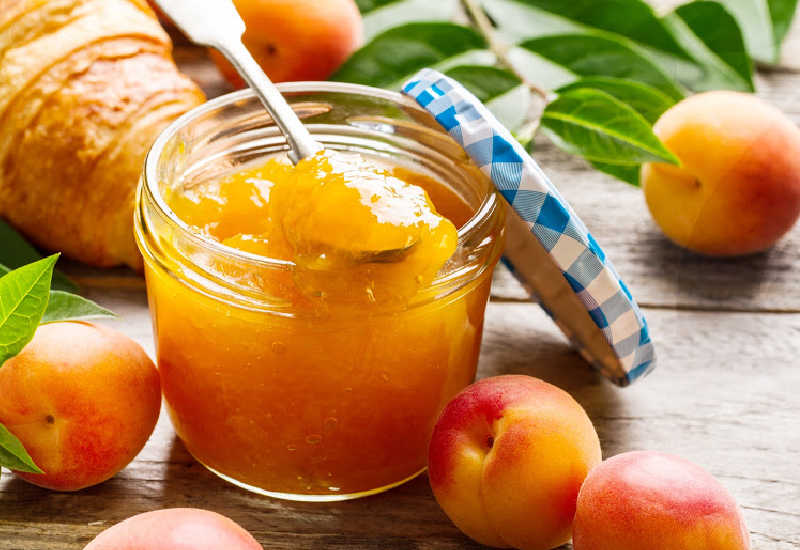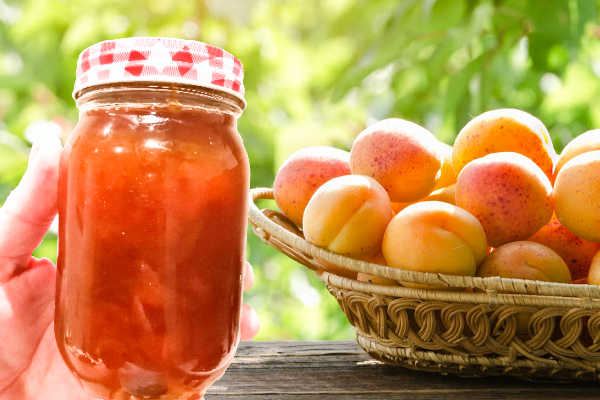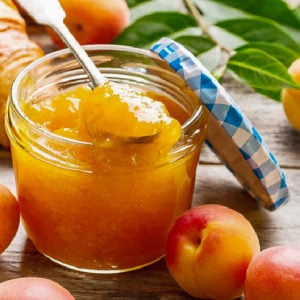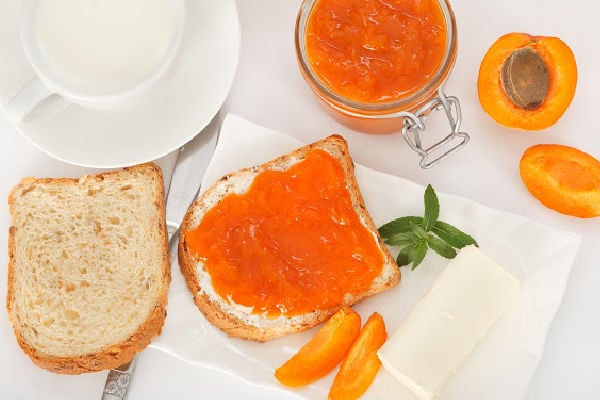When the apricot season reaches its peak, the stores are almost giving them away. This is your chance to buy in bulk then turn them into homemade apricot jam. I'm not convinced it's a huge money saver making your own, but it definitely tastes better and it's fun doing it yourself.

You're about to learn how to make your own batch of fresh jam. The good news is apricots are way easier to de-stone than other fruit and you don't have to bother peeling them. The whole process takes about two hours from start to finish.
Table of Contents
How to make apricot jam

Recipe

Easy Apricot Jam
Ingredients
- 8 cups apricots or 2 quarts
- ⅓ cup lemon juice
- 7 cups white sugar
- 5 canning jars 1 pint each
Instructions
- Break the apricots in half and remove the pits. Use a paring knife to cut off any blemishes or bruises.
- Wash the jars and lids then sterilize by boiling them in a water bath; keep the jars and lids in the bath until the jam is ready.
- Add apricots to a large pot along with the lemon juice and sugar; heat on medium-high until boiling, stirring occasionally.
- Reduce the heat to a gentle boil and cook for around 25 minutes until the apricot thickens. During cooking, use a spoon to scoop the white foam that rises to the top.
- Use a soup ladle to scoop carefully scoop the jam into jars, allowing a small space (about ¼”) at the top of the jar. Use a knife to remove air bubbles by running the blade around the inside of the jar. Give the jar rims a quick wipe to remove any spilled jam then top with the lids.
- Using a large stockpot, place a rack inside it and then pour in water to about halfway. Heat the water until boiling then reduce to a simmer and use a jar holder to carefully lower the jars into the water, ensuring they aren’t touching. If necessary, add more boiling water to the pot until the water is just above the tops of the jars. Place a lid on the pot and allow to boil for 15 minutes, then turn off the heat and transfer the jars to a cloth-covered bench.
- Allow the jars to cool before storing in a cool dark place such as a pantry or kitchen cupboard.
Notes
Here is how the process looks from start to finish. We picked our own fruit 😉

Tips for perfect apricot jam
Use the best apricots: Unlike banana bread which gets amazing flavor from overripe fruit, apricots used for jam shouldn't be left to ripen too much. Use firm apricots that have a little give rather than squishy ones.
Remove imperfections: Bruises and sunspots should be removed from the fruit before cooking. The skins of apricot are very thin so they don't need to be peeled, but you can remove them if you prefer.
Select the best cookware: Choose the widest saucepan you have available as the increased surface area helps the liquid evaporate faster.
Experiment with the ingredients: The sugar quantity can be adjusted to suit. Traditional jams use a ratio of roughly 1:1 sugar to apricots. For a low sugar option with fewer calories cut the sugar back a little. But remember it plays a role in helping set the jam and staving off mold so don't go overboard.
Adjust the quantities: This recipe works with smaller quantities of apricots; just remember to reduce the sugar and water proportionally.
Be flexible: If you discover that the final jam is very firm and over-set it can be used as part of a cheeseboard, similar to guava paste. For jam that’s too runny, stir it into your breakfast yogurt, pour it over ice cream, or reduce it in the frying pan for a decadent sauce.
Related reading:
What are some good apricot jam substitutes?
How to store apricot jam
Store apricot jam in a cool dark place such as a pantry or kitchen cupboard for up to one year. Always check the jam when opening to check for signs of mold.
If you have leftover jam at the end of the jarring process you can store it in an airtight container in the refrigerator for up to one week. Alternatively, you can freeze it for one year.
Suggested uses for apricot jam
- Slather it over camembert and bake until the cheese is gooey. The salty-sweet combination, scooped onto crackers, is to die for.
- Spread onto scones, toast, or muffins for breakfast or a mid-morning snack.
- Scoop onto ice cream, pudding, or dessert recipes that benefit from a little sweetness.
- Make a mouth-watering apricot jam crostata (Crostata di Marmellata).
- Top pancakes or crepes with jam and whipped cream for a decadent treat.

Fast facts
- Apricot jam can be heated in the microwave until runny and then brushed onto a cake for a great-looking shiny glaze.
- Apricots are low in pectin so you'll need to cook them longer than most other fruits.
- Cooking jam for a longer time results in a thicker, denser texture; you'll also end up with less jam the longer you cook it.
Related reading: If you enjoy making jam, check out our delicious strawberry jam recipe.
Do I need to use pectin to make apricot jam?
Pectin is a carbohydrate that naturally occurs in the skin and flesh of fruits. When cooked, the pectin is useful for binding the mixture into a gel. Apricots are low in pectin which means that you'll need to boil the fruit for longer than you would for apples or plums. Without adding jam setter (pectin), the result will be perfect, flavorsome jam, but it is unlikely to be as thick as the store-bought product. If this is a problem for you, then simply add a sachet of pectin which is often found in the baking section of grocery stores.
Summing up
Making apricot jam, like any DIY food project, is extremely rewarding and it’s foolproof. No matter how the final product turns out there will always be a tasty use for it in the kitchen.
Although it may be tempting to skip the jar sterilizing stage, don’t do it - foodborne illness isn’t pretty. You may also want to make this jam when the young ones aren’t nearby. Jam is unforgiving when it comes to burns so better to be safe than sorry.
What kind of jam do you love the most? Please let us know in the comments below and we'll add it to our growing recipe collection.

Leave a Reply